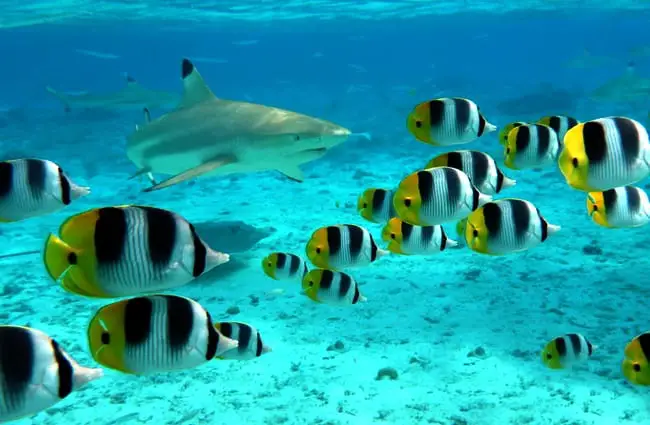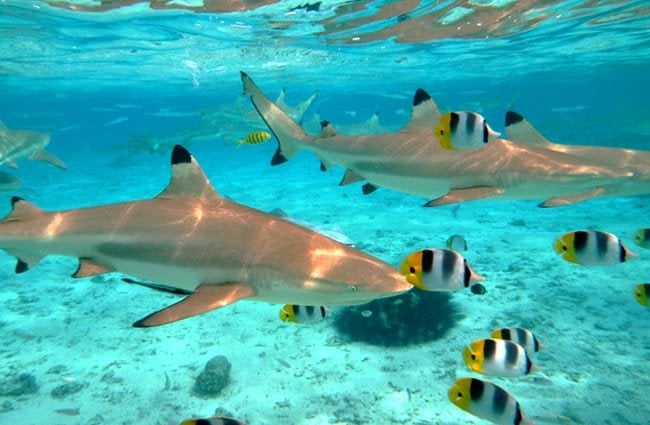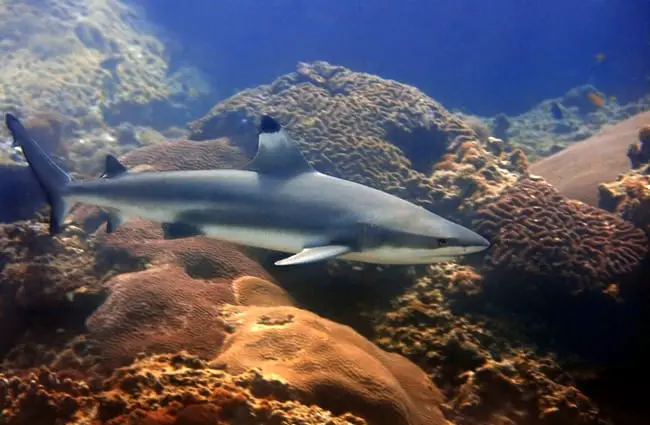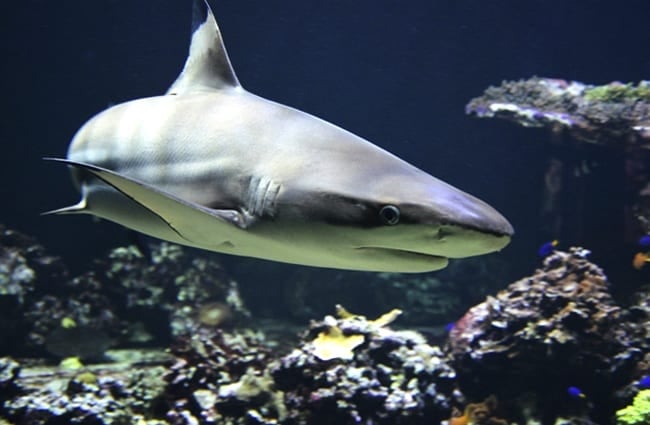The Blacktip Shark: An Agile Acrobat of the Coastal Seas
Dive into the vibrant, sun-drenched shallows of our planet’s oceans, and you might just catch a glimpse of one of the most dynamic and captivating predators: the Blacktip Shark. Known for its distinctive fin markings and acrobatic hunting style, this medium-sized shark is a true marvel of marine engineering and a vital component of coastal ecosystems worldwide. From its lightning-fast strikes on schooling fish to its crucial role in maintaining ocean health, the Blacktip Shark offers a fascinating window into the intricate lives of cartilaginous fish.
This article will explore the depths of Blacktip Shark knowledge, from its basic biology and behavior to its interactions with humans and its place in the grand tapestry of marine life. Whether you are a student researching its habitat, an animal lover hoping to spot one in the wild, an aspiring zoologist, or even a zookeeper caring for these magnificent creatures, prepare to be enlightened and entertained by the story of the Blacktip Shark.
Meet the Blacktip Shark: A Coastal Dynamo
The Blacktip Shark, scientifically known as Carcharhinus limbatus, is a member of the requiem shark family, a group renowned for its active, migratory, and predatory nature. Its common name is a direct nod to its most striking feature: the prominent black tips or margins on most of its fins, particularly the pectoral, dorsal, pelvic, and lower caudal fins. This sleek, torpedo-shaped shark is built for speed and agility, perfectly adapted for life in the bustling coastal waters it calls home.

Physical Characteristics and Identification
Typically reaching lengths of 1.5 to 2.5 meters (approximately 5 to 8 feet) and weighing between 50 to 100 kilograms (110 to 220 pounds), the Blacktip Shark is a formidable yet elegant predator. Its body is usually grey to brownish grey on the dorsal side, fading to a white underside, a classic countershading pattern that helps it blend into its environment from above and below. Beyond the black fin tips, other identifying features include a pointed snout, small serrated teeth designed for grasping and tearing, and a relatively small second dorsal fin.
Habitat and Global Distribution
One of the most widespread shark species, the Blacktip Shark thrives in tropical and subtropical waters across the globe. Its preferred habitat includes shallow coastal areas, estuaries, bays, lagoons, and coral reefs, often venturing into waters less than 30 meters (100 feet) deep. This preference for nearshore environments makes it a common sight for divers and snorkelers in many parts of the world.
Where to Find Them:
- Atlantic Ocean: From Massachusetts down to Brazil, including the Gulf of Mexico and the Caribbean Sea.
- Indian Ocean: Throughout the Red Sea, East Africa, Madagascar, and across to India and Southeast Asia.
- Pacific Ocean: From southern Japan, down through Australia, and across to Hawaii and other Pacific islands.
Their adaptability allows them to tolerate a range of salinities, often moving into brackish waters of estuaries, particularly during their younger stages. If you are an animal lover hoping to find a Blacktip Shark in the wild, coastal regions with clear, warm waters and abundant fish populations are your best bet. Look for them around reef edges, seagrass beds, and mangrove forests.

Diet and Hunting Strategies: The Spinning Predator
The Blacktip Shark is an opportunistic and highly effective predator. Its diet primarily consists of small schooling fish such as menhaden, sardines, mullet, anchovies, and herring. However, it is not averse to preying on other small sharks, rays, squid, and crustaceans when the opportunity arises. Their hunting technique is particularly famous: they are known for their spectacular “spinning” or “leaping” behavior, where they will burst out of the water while attacking dense schools of fish, often rotating their bodies in the air. This impressive display is not just for show, it helps disorient and scatter their prey, making them easier to catch.
Life Cycle and Reproduction: A Nursery in the Shallows
The reproductive cycle of the Blacktip Shark is a fascinating example of viviparity, meaning they give birth to live young. This process involves internal fertilization and a gestation period that typically lasts between 10 to 12 months.
Mating and Gestation
Mating usually occurs in the spring or early summer. Male Blacktip Sharks employ a courtship ritual that can involve biting the female to hold her in place during copulation. Females are thought to reproduce every other year, allowing them time to recover and replenish energy reserves.
Birth and Nursery Grounds
When it is time to give birth, pregnant females migrate to shallow, protected coastal areas such as estuaries, mangrove forests, and shallow bays. These vital “nursery grounds” provide a safe haven for the pups, protecting them from larger predators. A litter typically consists of 4 to 10 pups, each measuring about 55 to 65 centimeters (22 to 26 inches) at birth. These young sharks remain in the nursery areas for several months, feeding and growing before venturing into deeper waters.

Growth and Lifespan
Blacktip Sharks grow relatively quickly in their early years, reaching sexual maturity around 4 to 5 years of age for males and 6 to 7 years for females. Their average lifespan in the wild is estimated to be around 10 to 12 years, though some individuals may live longer under optimal conditions.
Ecology and Behavior: Guardians of the Coastal Ecosystem
Blacktip Sharks play a crucial role in maintaining the health and balance of coastal marine ecosystems. As apex predators in their environment, they help regulate the populations of their prey species, preventing overgrazing and promoting biodiversity.
Social Behavior and Migration
While often observed individually, Blacktip Sharks can also form large schools, particularly during their annual migrations. These migrations are often driven by seasonal changes in water temperature and the availability of prey. For instance, large aggregations are frequently seen off the coast of Florida during winter months, moving south to warmer waters. This schooling behavior can be a breathtaking sight for those lucky enough to witness it.
Interaction with Other Animals
Blacktip Sharks interact with a wide array of marine life. They are predators to many fish species, but they can also become prey themselves, especially when young. Larger sharks, such as Bull Sharks and Tiger Sharks, are known predators of juvenile and even subadult Blacktips. Their presence influences the behavior and distribution of many other species in the coastal food web.

Evolutionary History
The Blacktip Shark belongs to the family Carcharhinidae, which includes many of the most common and well-known shark species. This family has a relatively recent evolutionary history compared to some ancient shark lineages, with fossil records suggesting their diversification occurred during the Cenozoic Era, roughly 66 million years ago to the present. Their success is attributed to their adaptability, efficient predatory strategies, and ability to exploit diverse coastal habitats.
Blacktip Sharks and Humans: Coexistence and Conservation
Interactions between Blacktip Sharks and humans are relatively common due to their preference for shallow coastal waters. While generally shy, understanding their behavior is key to safe coexistence.
Interaction with Humans: Swimmers, Divers, and Fishermen
Blacktip Sharks are responsible for a notable number of unprovoked shark bites, particularly in areas like Florida. However, these incidents are almost always “hit and run” bites, where the shark quickly releases its grip after realizing its mistake. They are not typically aggressive towards humans and bites often occur in murky water or areas with high fish activity, where the shark may mistake a human limb for prey. For divers and snorkelers, Blacktips are generally curious but not threatening, often maintaining a respectful distance.
Safety Tips for Encounters
If you are a swimmer or a hiker encountering a Blacktip Shark in the wild, particularly in shallow waters, here are some practical tips:
- Stay Calm: Panicked movements can attract attention.
- Avoid Splashing: Erratic splashing can mimic the distress of prey.
- Swim Smoothly Away: Maintain eye contact if possible and slowly back away without turning your back.
- Avoid Murky Water: Blacktips hunt by sight and smell, and poor visibility increases the chance of mistaken identity.
- Do Not Wear Shiny Jewelry: Reflective objects can resemble fish scales.
- Avoid Swimming at Dawn or Dusk: These are prime hunting times for many shark species.
- Do Not Harass or Feed Sharks: This can habituate them to human presence and alter their natural behavior.
Conservation Status and Threats
The Blacktip Shark is currently listed as “Near Threatened” by the IUCN (International Union for Conservation of Nature). The primary threats to their populations include overfishing, particularly for their fins in the global shark fin trade, and incidental capture in commercial fisheries. Habitat degradation in their crucial nursery grounds also poses a significant risk. Conservation efforts focus on sustainable fishing practices, protection of nursery habitats, and public education to reduce demand for shark products.
Contribution to Human Culture
While not as prominently featured in folklore as some larger shark species, the Blacktip Shark is a symbol of the vibrant health of coastal ecosystems. Its presence is often celebrated by divers and wildlife enthusiasts, representing the wild beauty of our oceans. In some coastal communities, it is a traditional food source, though increasing awareness of its conservation status is shifting perspectives towards more sustainable interactions.

Caring for Blacktip Sharks in Captivity: A Zookeeper’s Guide
For zookeepers tasked with the care of Blacktip Sharks, providing an environment that mimics their natural habitat is paramount. These active, migratory sharks require specialized care to thrive in captivity.
Habitat Requirements
- Large Enclosures: Blacktip Sharks are highly active swimmers and require very large, circular or oval tanks to accommodate their constant movement and prevent collisions with tank walls. Tank size should be measured in hundreds of thousands of gallons.
- Water Quality: Pristine water quality is non-negotiable. This includes maintaining specific parameters for temperature (typically tropical range, 24-28°C or 75-82°F), salinity (marine levels, 30-35 ppt), pH, and dissolved oxygen. Robust filtration and life support systems are essential.
- Substrate and Decor: A naturalistic environment with sand or fine gravel substrate and minimal, smooth rockwork can provide enrichment without posing a risk of injury.
Dietary Needs
- Varied Diet: A diet consisting of a variety of high-quality, whole frozen fish (e.g., mackerel, herring, capelin) supplemented with squid and crustaceans is crucial. Vitamin supplements, especially B1 (thiamine), are often added to prevent deficiencies.
- Feeding Schedule: Regular, consistent feeding schedules are important. Food can be offered via target feeding to ensure each shark receives its portion and to monitor individual intake.
Health Monitoring and Enrichment
- Regular Health Checks: Daily visual inspections for any signs of injury, disease, or behavioral changes are vital. Regular veterinary check-ups, including blood work and physical examinations, are necessary.
- Stress Reduction: Minimize sudden changes in environment, loud noises, or excessive human traffic around the exhibit. Provide ample space and appropriate social groupings to reduce stress.
- Enrichment: While sharks do not engage in complex play, environmental enrichment can include varying feeding locations, introducing novel food items, or providing currents within the tank to stimulate natural swimming patterns.
What to Avoid
- Overcrowding: This leads to stress, aggression, and poor water quality.
- Sudden Changes: Avoid abrupt alterations in water parameters, lighting, or tank mates.
- Incompatible Tank Mates: Do not house Blacktip Sharks with overly aggressive species or fish small enough to be considered prey.
- Poor Nutrition: A monotonous or nutrient-deficient diet will lead to health problems.
- Rough Handling: If handling is necessary for medical procedures, it must be done by experienced professionals with minimal stress to the animal.
Interesting Facts About Blacktip Sharks
- Acrobatic Hunters: They are famous for leaping and spinning out of the water while hunting, a behavior known as “spinning.”
- Coastal Nomads: Blacktips undertake extensive seasonal migrations, often traveling thousands of kilometers.
- Nursery Specialists: Females utilize very shallow, protected coastal areas as vital nursery grounds for their pups.
- Speed Demons: Their streamlined bodies allow them to reach impressive speeds, making them highly effective pursuit predators.
- Mistaken Identity Bites: Most human bites are “hit and run” incidents, where the shark mistakes a human limb for prey in murky water.
- Sensitive Senses: Like all sharks, they possess an acute sense of smell, lateral line system for detecting vibrations, and electroreceptors (Ampullae of Lorenzini) to detect electrical fields of prey.
- Global Citizens: They are one of the most widely distributed shark species, found in tropical and subtropical waters worldwide.
Conclusion: Guardians of the Coastal Realm
The Blacktip Shark stands as a testament to the incredible diversity and resilience of marine life. From its iconic fin markings to its breathtaking hunting prowess, every aspect of its existence is finely tuned to its coastal environment. Understanding this magnificent creature not only enriches our appreciation for the natural world but also underscores our responsibility to protect it. By supporting conservation efforts, practicing responsible tourism, and educating ourselves and others, we can ensure that the agile Blacktip Shark continues to grace our oceans for generations to come, playing its vital role as a guardian of the coastal realm.

![Red Angus Closeup of a beautiful Red Angus cowPhoto by: U.S. Department of Agriculture [pubic domain]https://creativecommons.org/licenses/by/2.0/](https://animals.net/wp-content/uploads/2020/03/Red-Angus-4-238x178.jpg)




![Red Angus Closeup of a beautiful Red Angus cowPhoto by: U.S. Department of Agriculture [pubic domain]https://creativecommons.org/licenses/by/2.0/](https://animals.net/wp-content/uploads/2020/03/Red-Angus-4-100x75.jpg)

